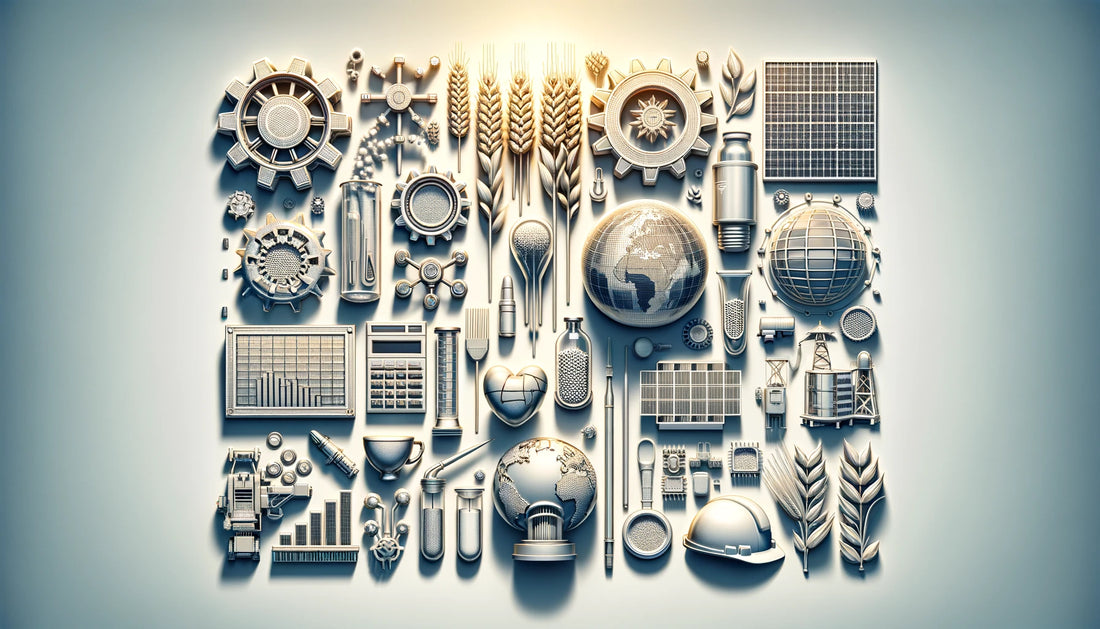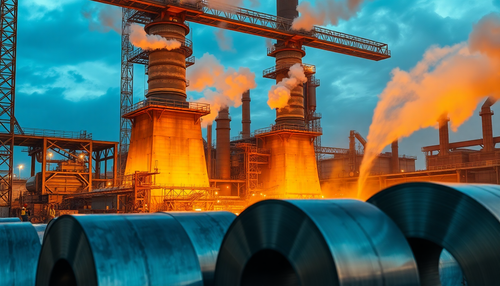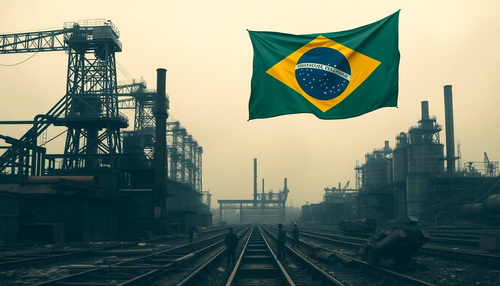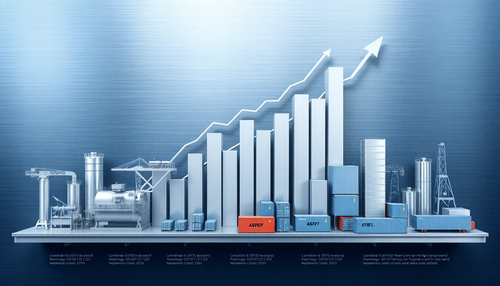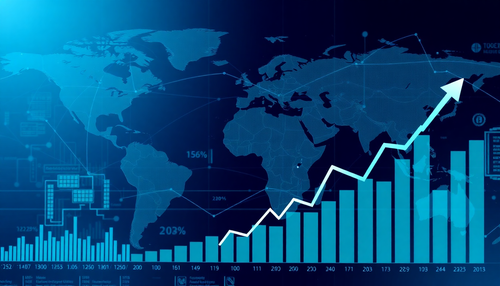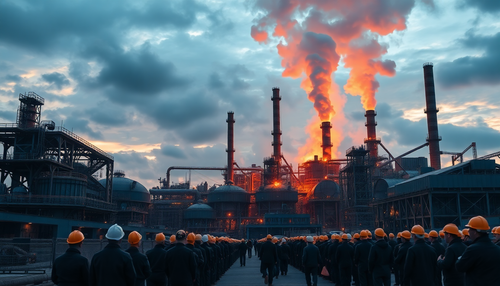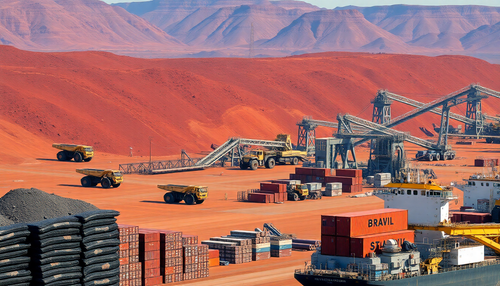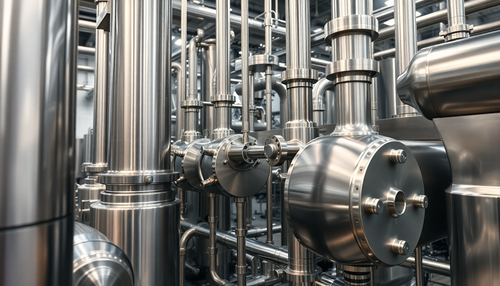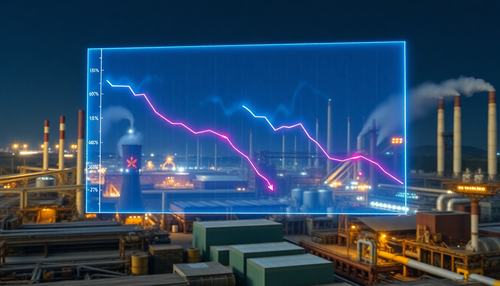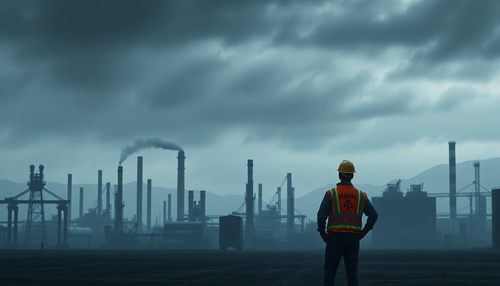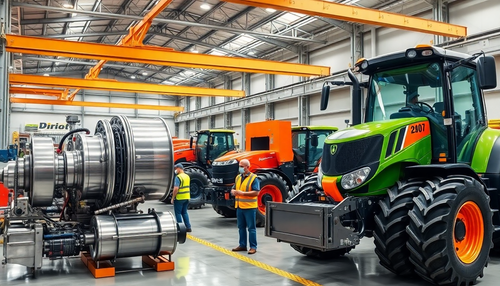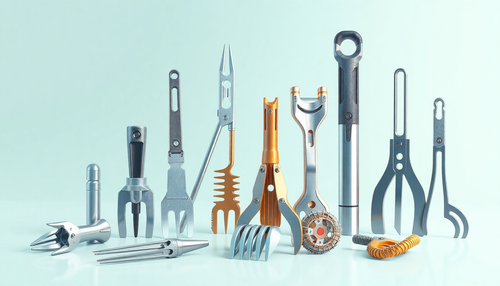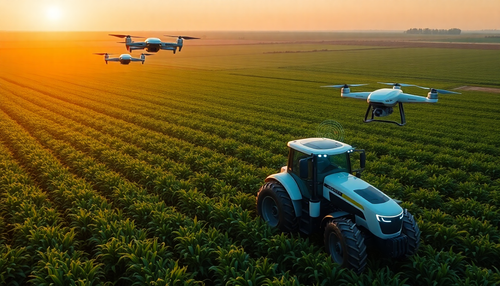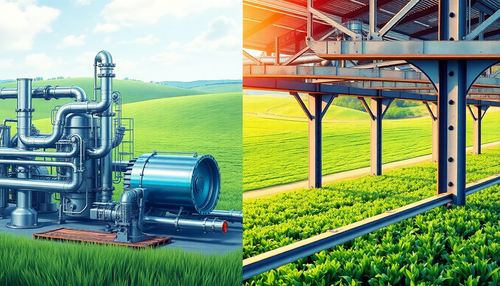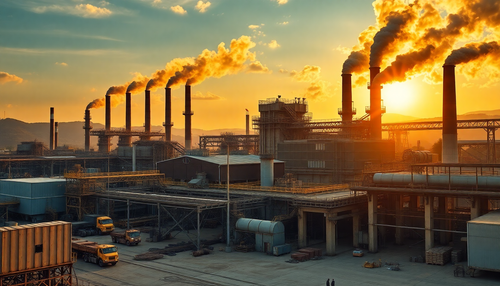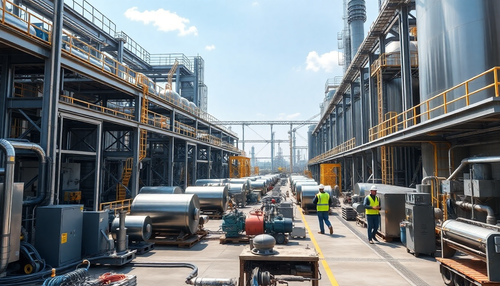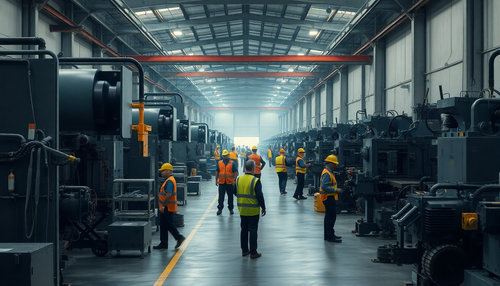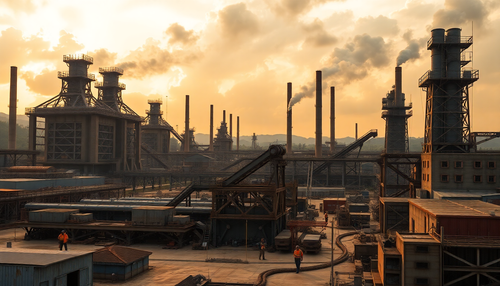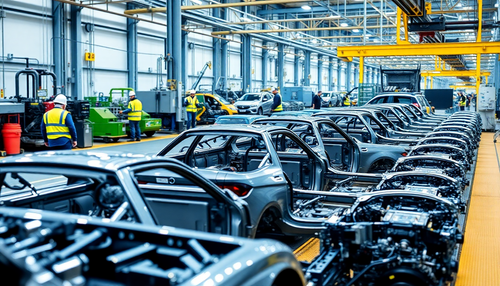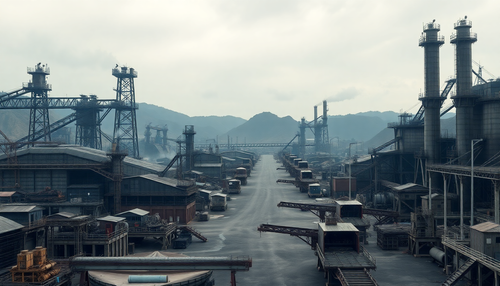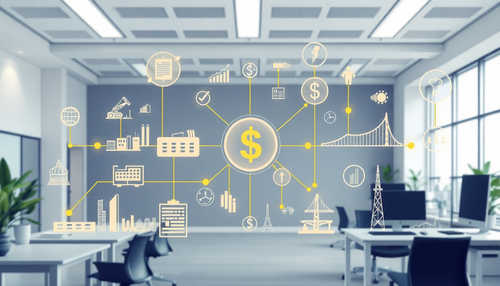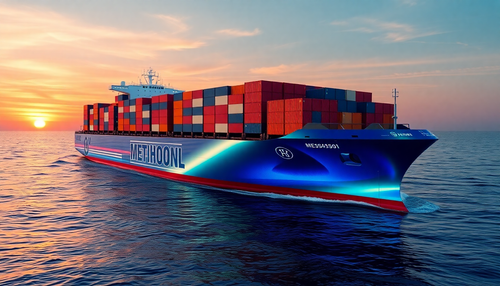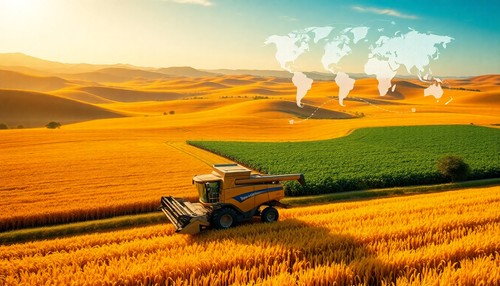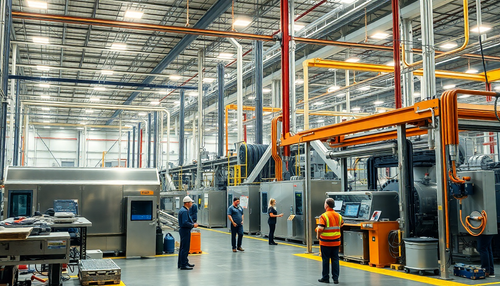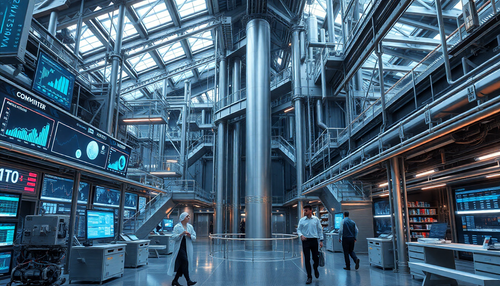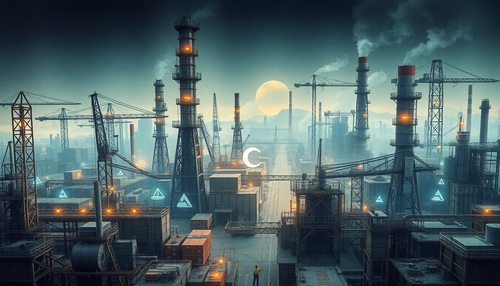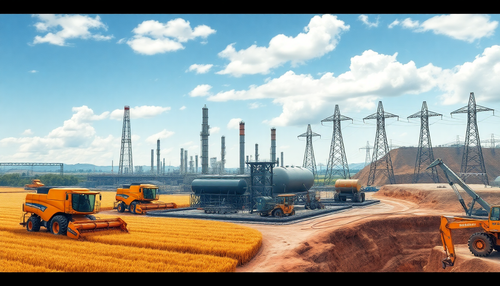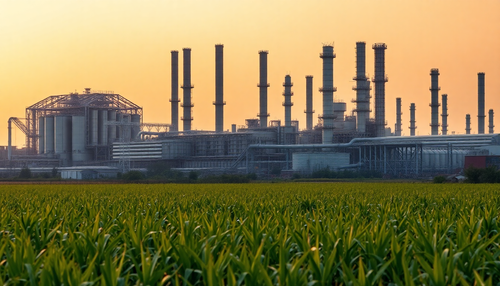Industry is a vital component of the global economy, encompassing a wide range of sectors that play essential roles in economic development, the production of goods and the provision of services. In this article, we will explore the main types of industries, from civil construction to the naval industry, highlighting their characteristics, challenges and impacts on society that we will talk about over the next few days.
- Production Goods Industry
The production goods industry is focused on the manufacture of equipment, machines and materials used in the production of other goods, both consumer and capital. It includes sectors such as the metallurgical industry, machinery and equipment, information technology, among others. Its main focus is to provide necessary inputs to other industries, playing a crucial role in the supply chain and economic development.
- Consumer Goods Industry
The consumer goods industry focuses on manufacturing products intended for end-use by consumers. This includes a wide range of items such as food, clothing, electronics, personal care products, furniture, and more. This industry is highly sensitive to market trends and consumer preferences, constantly seeking innovation, quality and efficiency to meet constantly evolving demands.
- Capital Goods Industry
The capital goods industry is responsible for the production of equipment and machines used in the production of other goods or in the provision of services. This includes industrial machinery, agricultural equipment, commercial vehicles, machine tools, among others. These goods are essential for the functioning of other industries and sectors of the economy, contributing to productivity and technological development.
- Other Types of Industry
In addition to the categories mentioned, there are other types of industry that play specific roles in the economy. This includes the service industry, which encompasses a wide range of activities not related to the production of tangible goods, such as financial services, education, healthcare and tourism. There are also emerging industries, such as the technology industry, which encompasses the development of software, hardware, telecommunications and other innovative technologies that drive the digital economy.
Construction
Civil construction encompasses a variety of activities related to building, infrastructure and urban planning. From the construction of residential and commercial buildings to the paving of roads and bridges, civil construction plays a fundamental role in the development of cities and improving the quality of life. Sustainable technologies, such as green construction, are increasingly present in the sector, promoting energy efficiency and reducing the environmental impact of construction projects.
- Sustainable Construction Processes: Exploration of sustainable construction practices and techniques, such as the use of recycled materials, water reuse systems and energy-efficient building design.
- Smart Construction Technologies: Discussion of emerging technologies in the construction sector, such as modular construction, 3D printing of buildings and the use of drones for monitoring works.
- Project and Construction Management: Analysis of project management methodologies and tools used in civil construction, including the use of BIM (Building Information Modeling) software and lean construction techniques.
- Trends in Architecture and Design: Exploration of contemporary trends in architecture and interior design, such as open spaces, integration with nature and the use of sustainable materials.
- Innovative Building Materials: Discussion of advances in building materials, such as high-resistance concrete, smart glass and state-of-the-art thermal and acoustic insulation.
- Work Safety in Construction: Analysis of safety practices and standards applied in construction sites, including the use of PPE (Personal Protective Equipment) and accident prevention programs.
- Urbanism and Urban Planning: Exploration of the principles of urbanism and urban planning, including the development of residential, commercial and industrial areas, as well as the integration of public transport and green areas.
- Transport Infrastructure and Urban Mobility: Discussion of the importance of transport infrastructure, such as roads, bridges and tunnels, and initiatives to promote sustainable urban mobility, such as cycle paths and efficient public transport.
- Renewable Energy Systems in Buildings: Analysis of renewable energy technologies applied in buildings, such as solar panels, rainwater harvesting systems and solar heating systems.
- Development of Modular Constructions: Exploration of the advantages of modular constructions, such as reduced construction time and costs, and examples of their application in different types of projects.
Engineering
Engineering is a broad discipline that covers several areas, including civil, mechanical, electrical and many others. Engineers are responsible for developing innovative projects, applying advanced technologies, and solving complex problems across a variety of industries. As technology advances, engineering is at the forefront of innovation, driving progress in areas such as renewable energy, transportation and healthcare.
- Fundamentals of Engineering: Exploration of the fundamentals of different areas of engineering, including civil, mechanical, electrical, among others.
- Project Development and Applied Research: Analysis of the project development process and the application of scientific research in engineering to solve complex problems.
- Innovations in Engineering Technologies: Discussion of the latest innovations in engineering technologies such as artificial intelligence, 3D printing, and nanotechnology.
- Modeling and Simulation of Complex Systems: Exploration of modeling and simulation techniques used to understand and optimize complex systems in engineering.
- Advances in Software Engineering: Analysis of advances in the area of software engineering, including agile methods, embedded software development and cybersecurity.
- Biomedical Engineering and Health Technologies: Discussion of advances in biomedical engineering and innovative technologies applied in the health sector, such as medical devices and prosthetics.
- Automation and Control of Industrial Processes: Exploration of automation and control systems used in industry to optimize production processes and increase operational efficiency.
- Risk Management in Engineering Projects: Analysis of risk management practices and techniques applied in engineering projects to mitigate possible failures and maximize success.
- Renewable Energy and Sustainability in Engineering: Discussion of renewable energy and sustainable practices applied in engineering to reduce environmental impact and promote sustainability.
- Engineering Challenges for the Future: Exploration of emerging challenges that engineering will face in the future, such as artificial intelligence, clean energy, and climate change adaptation.
Metallurgical industry
The metallurgical industry is involved in the production, processing and transformation of metals. From manufacturing automotive parts to producing metal structures, this industry plays a crucial role in a wide range of sectors, including automotive, aerospace, construction, and many others. Advanced manufacturing technologies such as 3D printing and nanotechnology are driving innovation in the metals industry, making products more efficient, durable and sustainable.
- Metallurgical Production Processes: Exploration of the main metal production processes, including casting, rolling and forging, and their application in the metallurgical industry.
- Metal Heat Treatment Technologies: Discussion of heat treatment technologies used in the metallurgical industry to modify the properties of metals, such as quenching and tempering.
- Metallic Alloys and Properties of Metals: Analysis of the most common metallic alloys and their mechanical, chemical and physical properties, and their application in different industrial sectors.
- Industrial Applications of Metals: Exploration of the applications of metals in the automotive, aerospace, construction and other sectors, highlighting their characteristics and advantages.
- Innovations in Metal Manufacturing Processes: Discussion of innovations in metal manufacturing processes, such as 3D printing, nanotechnology and additive manufacturing, and their impact on the metallurgical industry.
- Environmental Management and Sustainability in the Metallurgical Industry: Analysis of environmental management and sustainability practices adopted in the metallurgical industry to minimize environmental impact and promote corporate social responsibility.
- Quality and Process Control in the Metallurgical Industry: Exploration of quality control techniques and tools used in the metallurgical industry to ensure compliance of products and processes with established standards.
- Challenges and Opportunities of the Global Metallurgical Industry: Discussion of the main challenges and opportunities facing the global metallurgical industry, such as market competition, raw material price fluctuations and demand for sustainable products.
- Occupational Safety in Metallurgical Environments: Analysis of occupational safety practices applied in metallurgical environments, including the use of PPE, safety training and accident prevention programs.
- Trends in Metallurgical Materials and Technologies: Exploration of emerging trends in metallurgical materials and technologies, such as new metal alloys, advanced surface coatings, and the development of lightweight, high-strength materials.
Auto Industry
The automobile industry is one of the largest and most influential in the world, responsible for the production of passenger vehicles, trucks, buses and a variety of other means of transport. As technology advances, car manufacturers are investing in electric, autonomous and connected vehicles, seeking to reduce carbon emissions, improve safety and provide a more comfortable and convenient driving experience.
- Trends in Electric and Hybrid Vehicles: Exploration of trends in electric and hybrid vehicles, including battery technologies, range, charging infrastructure and environmental impact.
- Connectivity Technologies and Autonomous Vehicles: Discussion of connectivity technologies and advances in autonomous vehicles, including driver assistance systems, vehicle-to-vehicle and vehicle-to-infrastructure communication.
- Innovations in Automotive Design and Engineering: Analysis of innovations in automotive design and engineering, including aerodynamics, lightweight materials, ergonomics and user experience.
- Energy Efficiency and Sustainability in the Automotive Industry: Exploration of initiatives to improve the energy efficiency of vehicles and reduce carbon emissions, including alternative propulsion technologies and environmental regulatory policies.
- Manufacturing and Assembly of Vehicles and Components: Discussion of the manufacturing and assembly processes of vehicles and components, including stamping, welding, painting and final assembly.
- New Materials and Processes in the Automotive Industry: Analysis of new materials and processes used in the automotive industry, such as composite materials, 3D printing and additive manufacturing.
- Vehicle Safety and Regulatory Standards: Exploration of vehicle safety measures, including braking systems, airbags, stability control and safety standards established by regulatory bodies.
- Emerging Markets and Global Expansion of the Automotive Industry: Discussion of emerging markets in the automotive industry, such as China, India and Brazil, and the global expansion strategies of automakers.
- Preventive Maintenance and Vehicle Repairs: Analysis of preventative maintenance and vehicle repair practices, including warranty programs, after-sales services, and trends in autonomous maintenance.
- Urban Mobility Challenges and Opportunities: Exploration of urban mobility challenges and opportunities, including congestion, air pollution, public transport solutions, and trends in car sharing and mobility as a service.
Machinery Industry
The machinery industry encompasses the manufacture of a wide variety of equipment and devices used in industrial, agricultural and commercial processes. From high-precision machine tools to industrial robots and automated systems, this industry plays a key role in improving efficiency, productivity and quality across a variety of sectors. With the advancement of technology, machines are becoming increasingly intelligent, adaptable and connected, driving industry 4.0 and digital transformation.
- Industrial Automation and Robotics Technologies: Exploration of industrial automation and robotics technologies, including CNC systems, industrial robots, AGVs (automatically guided vehicles) and their application in industrial processes.
- Additive Manufacturing and 3D Printing: Discussion of additive manufacturing, also known as 3D printing, and its applications in the machinery industry, including rapid prototyping, custom parts manufacturing, and waste reduction.
- Development of Intelligent and Connected Machines: Analysis of the development of intelligent and connected machines, which use sensors, communication systems and data analysis to improve efficiency and productivity.
- Predictive Maintenance and Internet of Things (IoT) in Industry: Exploration of predictive maintenance, which uses sensors and data analysis to predict machine failures, and the integration of IoT in the machinery industry.
- Trends in Digital Manufacturing and Industry 4.0: Discussion of trends in digital manufacturing and Industry 4.0, including the integration of cyber-physical systems, the Internet of Things, cloud computing and big data in machine production.
- Machine Tools and Machining Equipment: Analysis of machine tools and machining equipment used in the machinery industry, including lathes, milling machines, grinding machines and machining centers.
- Quality Control and Machine Inspection: Exploration of quality control and machine inspection techniques and technologies, including computer vision inspection, non-destructive testing and statistical process control.
- Specific Applications of Machines in Industry: Discussion of the specific applications of machines in industry, such as in the automotive, aerospace, metallurgical, food industries, among others.
- Safety and Ergonomics Challenges in Industrial Environments: Analysis of safety and ergonomics challenges faced in the machinery industry, including accident prevention, workplace ergonomics and compliance with regulatory standards.
- Energy Efficiency and Sustainability in the Machinery Industry: Exploration of initiatives to improve energy efficiency and promote sustainability in the machinery industry, including the development of more efficient machines and the use of renewable energy.
Base industry
Basic industry is involved in the extraction, processing and production of raw materials and essential natural resources, such as minerals, oil, natural gas and forestry products. This industry provides the basic inputs needed to manufacture a wide range of products, including building materials, chemicals, plastics, energy, and many others. The sustainable management of natural resources is a growing concern in the basic industry, driving the adoption of environmentally responsible practices and technologies.
- Extraction and Processing of Natural Resources: Exploration of the techniques and processes involved in the extraction and processing of natural resources, such as minerals, oil, natural gas and forestry products.
- Development of Energy and Mineral Extraction Technologies: Discussion of the development of technologies for energy production and mineral extraction, including drilling, hydraulic fracturing and refining processes.
- Environmental Impacts and Sustainability in the Basic Industry: Analysis of the environmental impacts of the basic industry and initiatives to promote sustainability, such as recycling practices, water reuse and emissions reduction.
- Circular Economy and Industrial Waste Management: Exploration of the circular economy in basic industry, including industrial waste management, recycling of materials and use of by-products.
- Global Commodity and Raw Materials Markets: Discussion of global commodity and raw materials markets, including factors that influence prices, demand and supply, and market trends.
- Infrastructure and Logistics in Basic Industry: Analysis of the infrastructure and logistics necessary for the transport and distribution of basic industry products, including ports, railways, pipelines and storage.
- Development of Extraction and Refining Technologies: Exploration of technologies used in the process of extracting and refining natural resources, such as separation, purification and transformation technologies.
- Regulations and Standards in the Basic Industry: Discussion of the regulations and standards that govern the basic industry, including environmental issues, occupational health and safety, and quality standards.
- Innovations in Manufacturing and Industrial Production Processes: Analysis of innovations in manufacturing and industrial production processes in basic industry, including automation, digitalization and process optimization.
- Occupational Safety and Health Challenges in the Basic Industry: Exploration of challenges related to occupational safety and health in the basic industry, including accident prevention, risk management and compliance with regulations.
Mining Industry
The mining industry is responsible for extracting ores and minerals from the ground and subsoil. From the production of precious metals to the extraction of minerals used in the manufacture of industrial products, this industry plays a crucial role in the global economy. However, mining can also have significant impacts on the environment and local communities, making environmental and social management a priority for companies in the sector.
- Mining Methods: Exploration of different mining methods, including underground mining, open pit mining and dredging, highlighting their characteristics, advantages and challenges.
- Occupational Safety and Health in Mines and Quarries: Analysis of practices and regulations related to occupational safety and health in mining environments, with a focus on preventing accidents and occupational diseases.
- Mineral Exploration and Extraction Technologies: Discussion of the technologies used in mineral exploration and extraction, including methods of prospecting, drilling, detection and extraction of minerals.
- Ore Processing: Analysis of ore processing processes, such as crushing, grinding and separation, highlighting the steps and techniques involved in preparing ores for commercial use.
- Environmental Management and Sustainability in Mining: Exploration of environmental management practices and policies adopted by the mining industry to minimize the environmental impacts of the activity, including recovery and rehabilitation measures for degraded areas.
- Occupational Safety and Health in Mines and Quarries: Analysis of practices and regulations related to occupational safety and health in mining environments, with a focus on preventing accidents and occupational diseases.
- Socioeconomic Impact of Mining on Local Communities: Discussion on the impact of mining activity on local communities, including socioeconomic, cultural and environmental aspects, and initiatives to promote sustainable development.
- Sustainable and Responsible Mineral Exploration: Exploration of sustainable and responsible mineral exploration practices, including respect for the rights of local communities, conservation of biodiversity and mitigation of environmental impacts.
- Resource Recovery and Environmental Rehabilitation Technologies: Analysis of technologies and practices for recovery of mineral resources and environmental rehabilitation after the end of mining operations, aiming to restore affected areas and mitigate environmental impacts.
- Global Trends and Future Challenges in the Mining Industry: Discussion of emerging trends and future challenges facing the mining industry, including issues such as resource scarcity, climate change, environmental regulations and demand for strategic minerals.
Oil industry
The petroleum industry encompasses the exploration, production, refining and distribution of oil, natural gas and their derivatives. As one of the world's main sources of energy, this industry plays a central role in the global economy, influencing fuel prices, economic development and geopolitical relations. However, the oil industry also faces significant challenges related to sustainability, climate change and safety.
- Exploration and Production of Oil and Natural Gas: Analysis of the processes and technologies used in the exploration and production of oil and natural gas, including well drilling, extraction and development of reservoirs.
- Oil Refining and Processing: Exploration of the steps and technologies involved in refining and processing crude oil for the production of fuels and other derivatives, such as gasoline, diesel and lubricants.
- Offshore Drilling and Extraction Technologies: Discussion of the technologies and challenges associated with drilling and extracting oil and natural gas in offshore environments, including drilling platforms and subsea systems.
- Logistics and Transportation of Oil and Derivatives: Analysis of logistical operations and transportation systems used to move crude oil, refined products and derivatives, including oil pipelines, oil tankers and storage terminals.
- Alternative Energies: Exploration of alternative energies, such as biofuels, solar and wind energy, and their role in the energy transition and diversification of the global energy matrix.
- Environmental Management and Sustainability in the Oil Industry: Discussion of environmental management practices and policies adopted by the oil industry to minimize the environmental impacts of exploration, production and transportation of oil and natural gas.
- Global Energy Markets and Demand Forecasts: Analysis of trends and forecasts in global energy markets, including demand for oil, natural gas and other fossil fuels, as well as the impact of economic, political and technological factors.
- Innovations in Energy Exploration and Production: Exploration of technological innovations and business strategies in energy exploration and production, including the use of artificial intelligence, data analysis and automation.
- Rules and Regulations in the Oil and Gas Industry: Discussion of government rules and regulations applicable to the oil industry, including safety standards, environmental protection and exploration concessions.
- Safety and Risk Management Challenges: Analysis of safety and risk management challenges in the petroleum industry, including industrial accidents, oil spills, operational safety and disaster prevention.
Intermediate Goods Industry
Intermediate goods industries are responsible for the production and distribution of raw materials, components and semi-finished products used as inputs in other industries. These industries play a key role in the supply chain, providing the essential materials needed to manufacture a wide variety of end products. Innovation and efficiency in intermediate goods industries are essential to ensure competitiveness and economic growth in other sectors.
- Production and Distribution of Raw Materials and Components: Analysis of the production and distribution processes of raw materials, components and semi-finished products used as inputs in other industries.
- Logistics and Supply Chain: Exploration of logistics and supply chain systems in the intermediate goods industry, including transportation, storage and inventory management.
- Innovations in Manufacturing and Production Processes: Discussion of technological innovations and manufacturing processes adopted in the intermediate goods industry to increase efficiency and reduce costs.
- Quality and Process Control in Component Manufacturing: Analysis of quality control systems and quality assurance processes used in the manufacturing of components and semi-finished products.
- Trends in Materials and Production Technologies: Exploration of trends in materials and production technologies in the intermediate goods industry, including new materials, advanced manufacturing processes, and automation.
- Sustainability and Efficiency Challenges: Discussion of challenges related to sustainability and efficiency in the production of intermediate goods, including waste management, energy use and emissions reduction.
- Globalization and Competitiveness: Analysis of the impact of globalization on the intermediate goods industry and strategies to increase competitiveness in global markets.
- Collaboration and Partnerships: Exploration of collaboration and partnership strategies in the intermediate goods industry supply chain, including strategic alliances and cooperation between suppliers and manufacturers.
- Automation and Digitalization Technologies: Discussion of automation and digitalization technologies in the industrial production of intermediate goods, including the internet of things (IoT), artificial intelligence and digital manufacturing.
- Innovation Strategies: Analysis of innovation strategies and new product development in the intermediate goods industry, including investment in research and development, collaborative design and rapid prototyping.
Wood Industry
The timber industry is involved in forestry, wood processing and production of a variety of wood products, including furniture, paper, cellulose and biomass. In addition to providing construction materials and consumer products, the timber industry plays a crucial role in the conservation and sustainable management of forests. Responsible management of forest resources is fundamental to ensuring the long-term viability of the timber industry.
- Forest Exploitation and Sustainable Forest Management: Analysis of forest exploitation practices and sustainable management strategies to ensure forest conservation and resource renewal.
- Wood Processing and Beneficiation: Exploration of wood processing and processing processes, including cutting, drying, treatment and finishing of wood products.
- Wood and Composite Panel Production Technologies: Discussion of the technologies used in the production of wood panels, plywood, MDF and wood composites for various applications.
- Sustainability and Certification in the Timber Industry: Analysis of sustainability and forest certification initiatives in the timber industry, including programs such as the FSC (Forest Stewardship Council).
- Design and Manufacture of Furniture and Wooden Structures: Exploration of the design and manufacture of furniture, architectural structures and decorative wooden elements, highlighting contemporary techniques and trends.
- Applications of Wood in Civil Construction and Architecture: Discussion of the applications of wood in civil construction and architecture, including structures, coverings, floors and other construction elements.
- Trends in Biomaterials and Non-Wood Forest Products: Analysis of trends in biomaterials and non-wood forest products, such as cellulose, paper, resins and essential oils.
- Environmental Standards and Regulations in the Wood Industry: Exploration of environmental standards and regulations applicable to the wood industry, including legislation on deforestation, environmental protection and recovery of degraded areas.
- Global Wood Products Market and Consumer Trends: Analysis of the global wood products market, including consumption trends, demand for sustainable products and consumer preferences.
- Challenges of Forest Management and Biodiversity Conservation: Discussion of the challenges of forest management, biodiversity conservation and mitigation of environmental impacts associated with the timber industry.
Communication Industry
The communications industry encompasses a wide variety of activities related to the production and distribution of information, entertainment and media content. From television and radio to the internet and social media, this industry plays a key role in disseminating news, culture and entertainment to the general public. With the advent of the digital era, the communications industry has undergone a significant transformation, with the rise of new platforms and business models.
- Digital Transformation in Content Production and Distribution: Analysis of the changes caused by digital transformation in the production, distribution and consumption of media content.
- Growth of Streaming and VOD (Video on Demand) Platforms: Exploration of the growth of streaming and video on demand platforms, their impact on the industry and audience preferences.
- Adoption of Artificial Intelligence and Machine Learning in Content Personalization: Discussion on how artificial intelligence and machine learning are used to personalize content and recommendations for users.
- Development of New Forms of Narrative and Interactive Storytelling: Analysis of new forms of narrative and interactive storytelling made possible by digital technology, such as non-linear and participatory narratives.
- Challenges and Opportunities of Online Journalism and Social Media: Exploration of the challenges facing online journalism and social media, including misinformation, polarization and business models.
- Expansion of Podcasting and On-Demand Audio: Discussion on the growing popularity of podcasting and on-demand audio, its impact on the industry and audience preferences.
- Integration of Virtual Reality and Augmented Reality in the User Experience: Analysis of the integration of virtual and augmented reality technologies in the user experience in digital and entertainment content.
- Digital Content Monetization: Subscription, Advertising and Micropayment Models: Exploration of different digital content monetization models, including subscriptions, contextual advertising and micropayments.
- Ethics and Regulation in the Digital Age: Data Privacy and Combating Misinformation: Discussion of ethical and regulatory issues in the digital age, including data privacy, fake news and regulation of online platforms.
- Impact of Media Convergence on the Entertainment Industry and Popular Culture: Analysis of the impact of media convergence on the entertainment industry and popular culture, including new business models and forms of content consumption.
Aeronautical Industry
The aviation industry is responsible for the design, manufacture and operation of aircraft and aerospace systems. From commercial aviation to space exploration, this industry plays a crucial role in transporting passengers, cargo and scientific research. Advanced technologies such as electric propulsion and unmanned aircraft are driving innovation in the aviation industry, making travel safer, more efficient and more affordable.
- Development of Lighter, More Efficient and Sustainable Aircraft: Exploring efforts to develop aircraft that are lighter, more fuel efficient and environmentally sustainable.
- Advances in Composite Materials and Aeronautical Manufacturing Processes: Analysis of advances in composite materials and manufacturing techniques that contribute to the development of more advanced and efficient aircraft.
- Automation and Advanced Flight Control Systems: Discussion of automation and advanced flight control systems that are transforming aviation operations and increasing aircraft safety.
- Integration of Electric and Hybrid Propulsion in Aircraft: Exploration of electric and hybrid propulsion technologies that are being integrated into aircraft to make them more efficient and sustainable.
- Noise and Emissions Suppression Technologies in Airport Operations: Analysis of technologies and initiatives to reduce noise and emissions generated by airport operations and air traffic.
- Exploring New Urban Air Mobility (UAM) Concepts: Discussion of efforts to explore new urban air mobility concepts, including electric vertical takeoff and landing (eVTOL) vehicles and autonomous air taxis.
- Growth of the Unmanned Aerial Vehicles (UAVs) and Drones Market: Analysis of the growth of the unmanned aerial vehicles (UAVs) and drones market and its impact on the aeronautical industry and commercial and defense applications.
- Advances in Avionics and Aeronautical Communication Systems: Exploration of advances in avionics and aeronautical communication systems that are improving the efficiency and safety of aeronautical operations.
- Air Traffic Management Strategies to Deal with the Growth of Air Transport: Discussion of air traffic management strategies that are being developed to deal with the continued growth of air transport and ensure the safety and efficiency of operations.
- Challenges and Opportunities in the Adoption of Supersonic and Hypersonic Aircraft: Analysis of the technical, regulatory and operational challenges associated with the adoption of supersonic and hypersonic aircraft and the opportunities they represent for high-speed air transport.
Naval Industry
The naval industry encompasses the construction, repair and operation of ships, vessels and offshore platforms. From cargo ships and oil tankers to luxury cruises and military vessels, this industry plays a crucial role in maritime transportation, natural resource exploration and national defense. With increasing demand for energy and maritime transport, the shipping industry faces significant challenges related to safety, sustainability and technological innovation.
- Innovations in Naval Design: Smart Ships and Sustainability Concepts : Exploration of innovations in naval design, including smart ships and sustainable solutions to reduce the environmental impact of the shipping industry.
- Clean Marine Propulsion Technologies: Wind, Solar and Hybrid Power : Analysis of emerging clean marine propulsion technologies, such as wind, solar and hybrid power, that aim to reduce carbon emissions and promote sustainability in the shipping industry.
- Automation and Robotics in Vessel Construction and Operation : Discussion of the role of automation and robotics in the construction and operation of vessels, including autonomous systems and robots to increase the efficiency and safety of maritime operations.
- Development of Autonomous Ships and Unmanned Underwater Vehicles (AUVs) : Exploration of advances in the development of autonomous ships and unmanned underwater vehicles (AUVs) and their impact on the shipping industry, including applications for ocean exploration, maritime surveillance, and scientific research.
- Solutions for Energy Efficiency and Reducing Emissions on Ships : Analysis of solutions to increase energy efficiency and reduce emissions on ships, including more efficient propulsion technologies, route optimization and the use of alternative fuels.
- Environmental Monitoring and Marine Waste Management Technologies : Discussion of environmental monitoring and marine waste management technologies used in the shipping industry to protect marine ecosystems and reduce the environmental impact of operations.
- Sustainable Ocean Exploration: Undersea Resource Mining and Scientific Research : Exploration of sustainable ocean exploration practices, including underwater resource mining and scientific research to understand and protect marine ecosystems.
- Challenges and Solutions in Maritime Safety and Accident Prevention : Analysis of challenges and solutions in maritime safety and accident prevention, including safety technologies, crew training and regulations to ensure the safety of naval operations.
- New Materials and Construction Processes to Improve the Durability and Resistance of Vessels : Exploration of new materials and construction processes used in the naval industry to improve the durability, resistance and performance of vessels.
- Emerging Applications of Maritime Technology: Underwater Tourism, Wave Energy and Offshore Aquaculture : Discussion of emerging applications of maritime technology, such as underwater tourism, wave energy and offshore aquaculture, and their potential to drive growth and innovation in the shipping industry.
Food industry
The food industry plays a crucial role in the production, processing and distribution of food for human consumption. With growing concerns about food safety, sustainability and health, this industry faces significant challenges, but also offers opportunities for innovation and growth. Technologies such as biotechnology and automation are driving changes in the way food is produced and consumed. Additionally, issues such as food safety, labeling, food waste and consumer preferences are important themes that are shaping the future of the food industry.
- Food Consumption Trends: Exploration of changes in consumer food preferences, such as the search for healthy, natural and sustainable foods.
- Innovation in Food Technology: Discussion of technological advances in food production, such as advanced thermal processing, conservation techniques and intelligent packaging.
- Food Safety and Quality Control: Analysis of practices and regulations to ensure food safety and quality, including traceability systems and quality certifications.
- Sustainability in the Food Industry: Exploration of initiatives to reduce the environmental impact of food production, such as organic farming, vertical farming and regenerative farming practices.
- Supply Chain Challenges: Investigating challenges faced in the food supply chain, including transportation, storage and distribution of fresh and perishable foods.
- Biotechnology and Genetically Modified Foods: Debate about the benefits and concerns related to biotechnology in food production, such as genetically modified foods (GMOs) and disease-resistant crops.
- Labeling and Consumer Information: Discussion of the importance of accurate and transparent food labeling, including information about ingredients, nutritional value and origin of the food.
- Food Waste and Sustainable Solutions: Analysis of the causes and impacts of food waste and strategies to reduce waste along the supply and consumption chain.
- Functional Foods and Nutraceuticals: Exploring the growing demand for foods that offer health benefits beyond basic nutrition, such as functional foods and nutritional supplements.
- Impact of Digital Technology on the Food Industry: Investigating the ways in which digital technology, such as mobile apps, e-commerce and automation, is transforming food production, distribution and consumption.
Home Appliance Industry
The home appliance industry is a constantly evolving sector that encompasses the manufacturing of a wide range of electrical devices for residential and commercial use. Manufacturing processes include design, engineering, material selection, component manufacturing, assembly, quality testing and packaging. Key trends include energy efficiency, connectivity, sustainable materials and automation. These innovations aim to offer consumers more efficient, intelligent and sustainable products.
- Production Processes: Exploration of the different manufacturing processes used in the production of household appliances, including injection molding, stamping, welding and automated assembly.
- Raw Material: Analysis of the materials used in the manufacture of household appliances, such as stainless steel, engineering plastics, tempered glass and electronic components.
- Standards and Regulations: Discussion of standards and regulations applicable to the home appliance industry, including standards for electrical safety, energy efficiency and environmental sustainability.
- Energy Efficiency: Approach to initiatives and technologies aimed at improving the energy efficiency of household appliances, aiming to reduce energy consumption and operating costs for consumers.
- Trends in Design and Innovation: Exploration of the latest trends in home appliance design, including ergonomic, minimalist and integrated designs, as well as technological innovations such as touch screens and intuitive user interfaces.
- Connected Home Appliances: Analysis of the growing integration of IoT (Internet of Things) connectivity in home appliances, allowing remote control, automation and monitoring through smartphones and virtual assistants.
- Sustainable Materials: Debate on the use of sustainable and recyclable materials in the manufacture of household appliances, in line with consumer demands for more ecological and responsible products.
- Automation and Robotics: Discussion about automation and robotics applied to household appliance production processes, aiming to increase efficiency, precision and safety in assembly lines.
- Personalization and Customization: Exploration of trends in home appliance personalization, including offering consumers customization options, such as colors, finishes and additional features.
- Smart and Interactive Home Appliances: Analysis of emerging technologies, such as voice assistants and artificial intelligence, that are transforming home appliances into interactive devices that adapt to individual user preferences.
Agricultural Industry
The agricultural industry encompasses a wide range of processes and activities related to the production of food and products of animal origin. This includes everything from crop cultivation and management to livestock and poultry farming. Furthermore, it covers aspects such as irrigation and fertilization technologies, genetic improvement, animal health, food processing, logistics and distribution. The constant search for technological innovations and sustainable practices are essential to optimize productivity, ensure food safety and minimize environmental impacts.
- Precision Agriculture Technologies: Exploration of modern technologies, such as GPS, drones and sensors, applied in agriculture to optimize the use of inputs, increase productivity and reduce environmental impact.
- Sustainability in Agricultural Production: Analysis of sustainable practices adopted in the agricultural industry, including organic agriculture, crop rotation, soil conservation and integrated pest management.
- Biotechnology and Animal Genetics: Discussion of advances in biotechnology and genetic engineering applied to animal breeding, aiming to improve productivity, disease resistance and product quality.
- Trends in Digital Agriculture: Addressing emerging trends in digital agriculture, such as data-based agricultural management platforms, IoT (Internet of Things) and vertical farming.
- Specific Crop Management: Debate on specific management practices for different agricultural crops, such as grains, fruits, vegetables, coffee, among others, including planting, irrigation and harvesting techniques.
- Agricultural Policies and Agribusiness: Analysis of government policies and market trends that impact the agricultural industry, including subsidies, environmental regulations and trade agreements.
- Rural Property Management: Exploration of best rural property management practices, including agricultural planning, natural resource management, financial administration and family succession.
- Food Safety and Traceability: Discussion on food safety and traceability systems in the agricultural production chain, aiming to guarantee the quality and safety of food from its origin to the final consumer.
- Development of New Agricultural Products: Analysis of innovations in agricultural products, including functional foods, bioproducts, animal nutrition and food conservation and processing technologies.
- Challenges and Opportunities of Urban Agriculture: Exploration of the challenges and opportunities associated with urban agriculture, including growing in vertical spaces, green roofs, community gardens and the role of agriculture in food security in cities.
Textile industry
The textile industry is responsible for the production of a wide variety of fabrics, fibers and related products, playing a fundamental role in fashion, decoration and other sectors. From the cultivation and processing of natural and synthetic fibers to the weaving, dyeing and finishing of fabrics, this industry involves a series of complex processes. Furthermore, the search for innovation in materials, manufacturing techniques and sustainability is constant, aiming to meet the demands of the global market and promote responsible practices throughout the textile production chain.
- Textile Production Processes: Exploration of the main processes involved in the manufacture of fabrics, including spinning, weaving, dyeing, finishing and making parts.
- Raw Materials in the Textile Industry: Analysis of the main raw materials used in the textile industry, such as cotton, polyester, viscose, wool, silk and synthetic fibers, as well as trends in sustainable and recycled materials.
- Textile Manufacturing Technologies: Discussion of technological innovations applied in the textile industry, including state-of-the-art machines, process automation, digital textile printing and fabric additive manufacturing.
- Fashion Design and Trends: Covers fashion trends and clothing design, including colors, prints, cuts and styles, as well as the influence of social media and pop culture on the fashion industry.
- Sustainability in the Textile Industry: Analysis of sustainable practices adopted in the textile industry, such as recycling fabrics, reducing water and energy consumption, use of natural dyes and sustainability certifications.
- Standards and Regulations in the Textile Industry: Debate on the standards and regulations that govern the textile industry, including safety standards, quality, product labeling and labor rights.
- Marketing and Commercialization of Textile Products: Exploration of marketing and sales strategies in the textile industry, including branding, merchandising, e-commerce, digital marketing and internationalization strategies.
- Innovations in Technical and Smart Textiles: Discussion of advances in technical and smart textiles, including high-performance fabrics, smart textiles with sensors, and wearable technologies.
- Challenges of Globalization in the Textile Industry: Analysis of the challenges faced by the textile industry due to global competition, currency fluctuations, complex supply chains and issues related to ethics and social responsibility.
- Future Trends in the Textile Industry: Exploration of emerging trends that will shape the future of the textile industry, including mass customization, 4D printing, circular economy and on-demand production.
Chemical industry
The chemical industry is one of the most important and diversified, covering the production of a wide range of chemical products, from basic and intermediate products to final products used in different sectors of the economy. It plays an essential role in many aspects of modern life, providing essential chemical substances for the manufacture of pharmaceuticals, cosmetics, plastics, fertilizers, among others. The chemical industry is constantly searching for innovation, efficiency and sustainability, facing challenges related to safety, environmental regulation and global competitiveness.
- Chemical Production Processes: Understanding fundamental production methods, including chemical synthesis, industrial reactions, and separation techniques such as distillation and crystallization.
- Raw Materials and Inputs in the Chemical Industry: Exploring the sources of raw materials used in chemical production, such as petrochemicals, minerals and biomass, and their role in the manufacture of a wide range of chemical products.
- Segments of the Chemical Industry: Analyzing the different sectors of the chemical industry, including pharmaceutical, petrochemical, agrochemical and fine chemicals, and their respective applications and demands.
- Innovations in Chemical Technology and Research: Highlighting recent advances in technologies and research methods in the chemical industry, such as nanotechnology, green chemistry and biocatalysis, driving innovation and efficiency.
- Chemical Development and Regulation: Addressing the process of developing new chemical products, including safety testing, regulatory compliance and environmental standards.
- Sustainability and Social Responsibility in the Chemical Industry: Exploring sustainable initiatives and practices in the chemical industry, such as waste management, energy efficiency and corporate social responsibility.
- Global Markets and Trends in the Chemical Industry: Analyzing global chemical markets, consumer trends and regional demands, as well as the impact of international trade on the industry.
- Risk Management and Safety in Chemical Production: Discussing strategies and procedures to manage risks and ensure safety in chemical operations, including accident prevention and control of dangerous substances.
- Role of the Chemical Industry in Health and Well-being: Exploring the contribution of the chemical industry to human health and well-being, through the production of medicines, hygiene and cleaning products, among others.
- Future Prospects and Challenges of the Chemical Industry: Considering emerging trends, such as digitalization, automation and circular economy, and the challenges faced by the industry, such as stricter regulations and demands for sustainability.
Steel industry
The steel industry is essential for the manufacture of a wide variety of products, from metal structures for civil construction to automotive parts and industrial equipment. Its processes involve the transformation of raw materials such as iron ore, coal and scrap metal into steel, using methods such as blast furnaces and electric arc furnaces.
The industry is constantly seeking innovations to improve the efficiency of production processes, reduce environmental impact and develop new applications for steel. However, it faces challenges related to waste management, quality control, workplace safety and global competition. The steel market is influenced by economic, political and technological factors, reflecting the demands of sectors such as construction, automotive and infrastructure.
- Steel Production Processes: Exploration of steel production methods, including blast furnace, electric arc furnace, basic oxygen furnace and vacuum refining process.
- Raw Materials and Inputs in the Steel Industry: Analysis of the raw materials used in steel production, such as iron ore, coal and metal scrap, and their importance in the quality and cost of the final product.
- Technologies and Innovations in the Steel Industry: Emerging technologies in the steel industry are highlighted, including direct reduction processes, waste recycling and advanced quality control techniques.
- Steel Products and Applications: Exploration of different types of steel products, such as sheets, profiles, tubes and wires, and their applications in sectors such as civil construction, automotive, naval and energy.
- Environmental Challenges in the Steel Industry: Discussion of the environmental challenges faced by the steel industry, including greenhouse gas emissions, consumption of natural resources and waste management.
- Quality and Process Control in Steel: Coverage of quality control techniques and standards applied in steel production, ensuring product compliance with technical specifications and regulations.
- Global Market and Trends in the Steel Industry: Analysis of the global panorama of the steel industry, including demand for steel, raw material prices, trade policies and technological trends.
- Waste Management and Recycling in the Steel Industry: Exploration of waste management practices in the steel industry, such as recycling metal scrap, reusing slag and treating effluents.
- Occupational Safety and Health in the Steel Industry: Discussion of the safety measures adopted in steelmaking facilities to prevent workplace accidents and protect the health of workers.
- Socioeconomic Impact of the Steel Industry: Consideration of the effects of the steel industry on the local and global economy, including job creation, infrastructure development and contribution to GDP.
CONCLUSION
As we move forward with our new project exploring different industries, we are facing a horizon full of opportunities and challenges. The integration of emerging technologies such as artificial intelligence, the Internet of Things and cloud computing promises to revolutionize the way these industries operate, driving efficiency, innovation and sustainability.
However, we will also face significant obstacles, from the need to transition to more sustainable practices to adapting to changing market demands and evolving regulations. By approaching these challenges with determination and creativity, we can build a future where industries not only thrive, but also contribute to a more equitable, resilient and prosperous world for all.
Join us on this explanatory journey about processes and new technologies in the industry in general.

